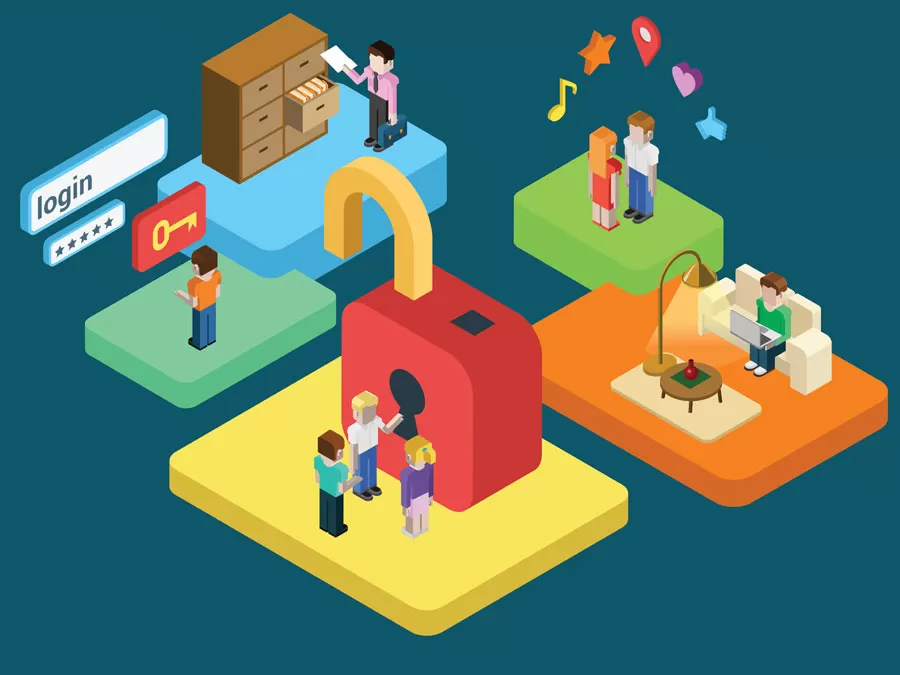What’s the secret to impeccable customer service? Having a 360-degree view of customers.
To truly cater to their needs and deliver personalized experiences, businesses must strive to achieve a 360-degree view of their customers. In this blog, we will explore the concept of a 360-degree view and discuss how it can empower your business to make data-driven decisions, enhance customer engagement, and drive long-term loyalty.
Understanding the 360-Degree View of Customers
A 360-degree view refers to the comprehensive understanding of each individual customer based on a holistic collection and analysis of their data. It involves gathering data from various sources, integrating it into a centralized system, analyzing it to gain insights, and leveraging those insights to personalize customer experiences and improve customer journey mapping.
Achieving a 360-degree view is all about harnessing the power of data to gain a deep understanding of your customers’ preferences, behaviors, and needs. These pieces of information can be used to unlock valuable insights that enable you to make informed business decisions and tailor your offerings to meet customer expectations.
Collecting Customer Data
The foundation of achieving a 360-degree view lies in collecting comprehensive customer data to gain a more complete picture of your customers. Valuable sources include:
- Transactional data, which provides insights into customer purchasing behavior;
- Interaction data, which captures their engagement and preferences;
- Demographic data, which helps understand their characteristics; and
- Social media data, which offers valuable insights into their interests and opinions.
To collect this data effectively, businesses can leverage advanced tools and technologies. Customer Relationship Management (CRM) systems are a popular choice as they allow for centralized data storage and easy access. A CRM software’s best output aids businesses in customer relationship analytics.
Marketing automation tools can help capture and track customer interactions, while data analytics platforms enable deeper analysis and extraction of actionable insights. Both of these technologies help in customer data integration and customer journey mapping.
Integrating Data from Multiple Channels
One of the challenges businesses face in achieving a 360-degree view is data fragmentation. Customer data often resides in silos across different channels and systems, making it difficult to gain a holistic understanding.
Customer data integration is the key to overcoming this challenge. It enables businesses to gain a comprehensive understanding of customer behavior, preferences, and needs. It ensures that customer data is up-to-date, accurate, and accessible, enabling effective analysis and personalized engagement.
Analyzing and Segmenting Customer Data
Once the data is integrated, the next step is to analyze and segment it to derive meaningful insights. Data analysis is the process of mining customer data to identify patterns, trends, and customer preferences. This process helps a lot in customer journey mapping.
Segmentation allows businesses to tailor their marketing efforts and engagement strategies to specific customer groups. By understanding the unique needs and preferences of different customer segments, businesses can deliver targeted messaging, personalized recommendations, and relevant offers that resonate with each group.
Personalizing Customer Experiences
Personalization lies at the heart of achieving a 360-degree view of customers. Leveraging the insights gained from customer relationship analytics and data segmentation, businesses can deliver highly personalized experiences.
Tailored marketing campaigns, customized product recommendations, and personalized customer support can significantly enhance the customer experience. All of this is possible with the help of customer data integration and customer journey mapping.
Personalization fosters a sense of relevance and value, leading to increased customer satisfaction and loyalty. By addressing individual needs and preferences, businesses can build strong and lasting relationships with their customers, fostering a sense of loyalty and creating brand advocates.
Enhancing Customer Engagement and Retention
Customer engagement and retention are critical factors in long-term business success. By leveraging the 360-degree view of customers, businesses can drive meaningful engagement and improve customer retention rates.
With a comprehensive understanding of customers through customer data integration, customer relationship analytics, and customer journey mapping, businesses can develop targeted marketing communications, loyalty programs, and proactive customer support initiatives.
- Targeted marketing communications ensure that customers receive relevant offers and messages, increasing the likelihood of conversion and repeat business. By analyzing customer data and understanding their preferences, businesses can tailor their marketing campaigns to specific segments, delivering personalized content that resonates with each customer group.
- Loyalty programs and rewards incentivize customers to stay loyal to your brand. By leveraging customer data, you can create loyalty programs that offer rewards and incentives based on individual customer behavior and preferences.
- Proactive customer support involves anticipating customer needs and providing timely assistance. By analyzing customer interactions and purchase history, businesses can identify potential pain points and proactively address them, ensuring a seamless customer experience.
Ensuring Data Privacy and Security
While harnessing customer data is essential, it is equally important to prioritize data privacy and security. Customers are increasingly concerned about how their data is handled and expect businesses to safeguard their information. Compliance with regulations such as the General Data Protection Regulation (GDPR) is crucial.
To ensure data privacy and security, businesses should implement robust data protection measures. This includes securing data storage systems, employing encryption technologies, customer data integration best practices, and implementing strict access controls.
Additionally, businesses must be transparent in their data collection practices, providing clear communication about how customer data is collected, used, and protected.
Overcoming Challenges and Limitations
Achieving a 360-degree view of customers comes with its share of challenges, but here are the most common:
- Ensuring data quality: Incomplete or inaccurate data can hinder the effectiveness of customer relationship analytics and segmentation efforts as well as customer journey mapping.
Businesses must address data quality issues by implementing data cleansing processes, conducting regular data audits, and ensuring ongoing data governance and maintenance.
- Balancing personalization and privacy: While customers appreciate personalized experiences, businesses must be mindful of respecting their privacy and obtaining proper consent for data usage.
Transparency and clear communication about data collection and usage practices are key to building trust and maintaining a positive customer perception.
The Future of Customer Data Management
The field of customer data management is constantly evolving. Emerging technologies such as artificial intelligence (AI), machine learning, predictive customer relationship analytics, and real-time insights hold great promise, especially in areas like customer journey mapping.
AI-powered algorithms can analyze vast amounts of customer data to uncover hidden patterns and predict customer behavior, enabling businesses to stay one step ahead. Real-time insights provide up-to-the-minute information, allowing businesses to respond promptly to changing customer needs and preferences.
As the field continues to evolve, businesses should stay informed about emerging trends and adopt innovative solutions to stay competitive and deliver exceptional customer experiences. Brands should also never forget changes on customer data integration.
The Power of Outsourcing in Understanding Your Customers
Outsourcing customer support can significantly contribute to a better understanding of your customers and their needs. By entrusting this critical function to a specialized external partner, you can leverage their expertise and resources to gain valuable insights and enhance your customer knowledge.
In this section, we will explore how outsourcing customer support can help your business better understand your customers.
- Access to Specialized Skills and Expertise
Outsourcing customer support allows you to tap into the specialized skills and expertise of a dedicated team.
Customer support providers specialize in delivering exceptional service and have extensive experience in handling various customer inquiries and concerns. Their expertise enables them to effectively gather customer feedback, analyze patterns, and identify emerging trends. All of these are helpful in customer journey mapping and customer relationship analytics.
By leveraging the expertise of an outsourcing partner, you can gain insights into customer behavior, preferences, pain points, and satisfaction levels, not to mention customer data integration. Their proficiency in handling customer interactions allows them to uncover valuable information that can be used to improve products, services, and overall customer experience.
- Multichannel Support and Data Collection
Outsourcing customer support often includes multichannel support capabilities. This means that your outsourcing partner can engage with customers across various channels such as phone, email, live chat, and social media. By having a presence on multiple channels, you can gather a wealth of customer data from different touchpoints.
Through each customer interaction, whether it’s a support ticket, a social media message, or a phone call, your outsourcing partner can collect valuable information about customer preferences, needs, and pain points. This data can be analyzed and consolidated to create a comprehensive view of your customers and their journey with your brand.
- Data Analysis and Reporting
Outsourcing customer support goes beyond just resolving customer inquiries. It involves robust customer relationship analytics and reporting capabilities. Customer support providers have the tools and expertise to analyze the data collected from customer interactions and generate insightful reports.
The analysis can uncover patterns and trends, helping you identify areas for improvement, develop targeted marketing strategies, improve customer journey mapping, and make data-driven decisions to enhance the overall customer experience.
- Scalability and Flexibility
As your customer base grows or during peak periods, your outsourcing partner can easily scale their operations to handle increased support volume. This ensures that customers receive timely assistance and support, maintaining high levels of customer satisfaction.
Moreover, outsourcing allows you to access support services 24/7, providing round-the-clock coverage to your customers. This availability enables you to capture customer feedback and insights at any time, improving your understanding of customer needs across different time zones and regions.
- Continuous Improvement and Innovation
Outsourcing customer support promotes a culture of continuous improvement and innovation. Customer support providers are dedicated to enhancing customer satisfaction and are constantly looking for ways to optimize their processes and exceed customer expectations, including customer journey mapping.
By collaborating with an outsourcing partner, you can tap into their experience, knowledge, and best practices. They can share valuable insights and recommendations to improve your customer support operations, refine your products or services, identify opportunities for innovation, and customer data integration needs.
- Cost Savings and Resource Allocation
Outsourcing customer support can also provide cost savings and allow for better resource allocation. Maintaining an in-house customer support team requires significant investments in hiring, training, infrastructure, and ongoing management. By outsourcing, you can reduce these costs and allocate your resources more efficiently to focus on your core business operations.
The cost savings from outsourcing can be redirected to other areas such as marketing research, product development, or enhancing customer engagement initiatives. This allows you to invest in activities that further deepen your understanding of your customers and drive business growth.
Achieving a 360-degree view of customers is a strategic imperative for businesses seeking sustainable growth and success. Here are some of the key points to consider:
- Through comprehensive data collection, customer data integration, data segmentation and analysis, and personalized experiences, businesses can foster strong customer relationships, enhance engagement, and drive long-term loyalty.
- While challenges and limitations exist, businesses must address them through robust data quality control, balancing personalization with privacy concerns, and prioritizing data privacy and security. These measures may aid in various aspects from customer journey mapping to providing top-notch solutions.
- By staying attuned to the evolving landscape of customer data management and adopting emerging technologies pertaining to customer relationship analytics, businesses can stay ahead of the curve and create meaningful experiences that resonate with their customers.
Harnessing the power of a 360-degree view of customers positions your business as a customer-centric organization. It enables you to make data-driven decisions, develop targeted marketing strategies, and deliver personalized experiences that exceed customer expectations.
Remember, your customers are at the core of your business. By understanding them inside out, you gain a competitive edge and position your business for long-term success. Start your journey towards a 360-degree view today and witness the transformative power it has on your customer relationships, business growth, and bottom line.
If you need help in achieving a 360-degree view for your customers or in utilizing crucial information you ve obtained, Open Access BPO can help you provide the right kind of business solutions wherever your customers are along their buyer s journey. Ask us how we can help you.
The volume of online customer data available to entrepreneurs can both be overwhelming and extremely beneficial to businesses.
It takes a special set of skills to be able to navigate through forests of data and eventually translate them into a solid customer support program.
On the other hand, every single byte is an opportunity for brands to create meaningful connections with customers. According to several sources, over 70% of consumers prefer brands that personalize their experience using relevant online data. Personalized recommendations, targeted advertising, and cross-channel shopping are all pleasurable perks resulting from fully understanding your customers.
To improve your marketing strategy, follow these tips in achieving a 360-degree view of your customers based on online interactions.
-
Focus on first-party data.
There’s not a more reliable form of customer data than those you personally gathered from your customers. To fully understand the customer identity, the first step is to forge a genuine, two-way relationship with them. Creating cross-platform points of transactions, such as email subscriptions, site analytics, and filled out forms, also lets you capture first-party data.
As these pieces of data directly come from your market, it promotes transparency in data collection and doesn’t breach the customer’s privacy in any way.
-
Require user registrations and logins.
Another way to leverage customer information and get your hands on first-party data is by requiring user registrations and logins. There are several options for a registration prompt.
You may ask site visitors to login by linking their social media accounts, or you may opt for the traditional signup procedure by collecting the user’s name, email address, and other relevant information. Whatever format you choose, however, make sure that it allows enough flexibility and accessibility for your customers.
-
Conduct your own research.
The Internet has pretty much everything at your disposal if you know how to look for what you need and where to look for it. Aside from rounding up blog posts, user comments, market research, and other public data, you can also launch a quick customer survey online. This way, you can specify the information that you need from customers and increase their engagement with your brand as well. Afterward, the insights you gained from your research would serve a useful purpose as you formulate an efficient marketing strategy.
However, with privacy laws governing over international jurisdictions, you must inform your customers how you intend to utilized the information you collect from them.
-
Organize your data.
Data organization is perhaps the most crucial step in understanding your customers. It involves indexing sources and storing, categorizing, and retrieving information, both of which require a lot of effort from marketers.
Structured data with definite values such as name, email address, home address, birth date, or gender are easier to organize. However, unstructured ones such as social shares, preferred brands, photos, and connections are more difficult to make sense of. If your data organization mechanism isn’t solid and specific enough, the entire analytics process could also fail.
-
Apply the right analytics.
This is where most of your technical skills would come into play. By applying the right analytics or statistical procedures, you’re actually transforming data into actionable insights that would inform your customer support and marketing strategy.
You need to gather a team made up of professionals with different expertise. Tech, statistics, social, and digital skills will be equally useful as you aim to understand what your customers are saying.
Customer data present a rich opportunity for businesses to create lasting impressions upon their target demographic. It can be immensely challenging, but it’s a sure path toward long-term success.
If you need help in achieving a 360-view or your customers or in utilizing crucial information you’ve obtained, Open Access BPO can help you provide the right kind of business solutions wherever your customers are along their buyer s journey. Ask us how we can help you.





